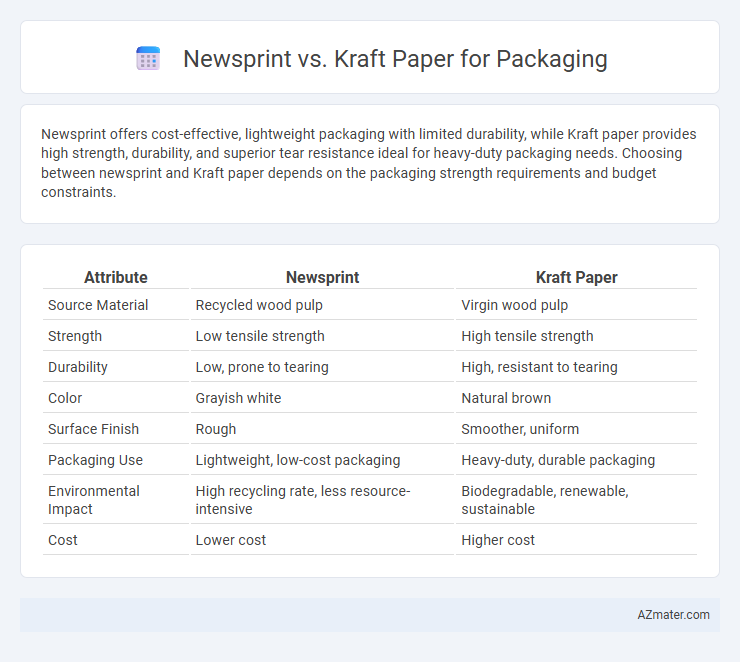Newsprint offers cost-effective, lightweight packaging with limited durability, while Kraft paper provides high strength, durability, and superior tear resistance ideal for heavy-duty packaging needs. Choosing between newsprint and Kraft paper depends on the packaging strength requirements and budget constraints.
Table of Comparison
| Attribute | Newsprint | Kraft Paper |
|---|---|---|
| Source Material | Recycled wood pulp | Virgin wood pulp |
| Strength | Low tensile strength | High tensile strength |
| Durability | Low, prone to tearing | High, resistant to tearing |
| Color | Grayish white | Natural brown |
| Surface Finish | Rough | Smoother, uniform |
| Packaging Use | Lightweight, low-cost packaging | Heavy-duty, durable packaging |
| Environmental Impact | High recycling rate, less resource-intensive | Biodegradable, renewable, sustainable |
| Cost | Lower cost | Higher cost |
Overview: Newsprint vs Kraft Paper for Packaging
Newsprint and kraft paper serve distinct roles in packaging, with newsprint primarily used for lightweight wrapping and cushioning, offering cost-effectiveness and recyclability. Kraft paper, known for its superior strength and durability, is favored for heavy-duty packaging and protective wrapping, often sourced from sustainable wood pulp. The choice between newsprint and kraft paper hinges on packaging requirements like strength, protection level, environmental impact, and budget considerations.
Composition and Manufacturing Process
Newsprint is primarily composed of recycled wood pulp with minimal chemical treatment, produced through a less intensive mechanical pulping process that retains high lignin content, resulting in a lightweight and low-cost paper ideal for printing. Kraft paper, derived from virgin wood fibers via the kraft process, undergoes chemical pulping that removes lignin and impurities, producing strong, durable fibers suited for heavy-duty packaging applications. The kraft manufacturing process includes chemical digesters and washing stages that enhance fiber strength and resistance, whereas newsprint manufacturing emphasizes speed and cost-efficiency with less rigorous fiber treatment.
Physical Properties and Durability
Newsprint features lower tensile strength and is thinner, making it less suitable for heavy-duty packaging, while Kraft paper offers superior durability with high tear resistance and thickness. Kraft's robust fibrous structure enhances its ability to withstand rough handling and moisture exposure, ensuring better protection for packaged goods. Newsprint's smoother surface is more prone to tearing and deformation, limiting its use to lightweight, non-rigid packaging applications.
Printability and Surface Texture
Newsprint offers a smooth surface texture that enhances printability, making it ideal for high-quality image reproduction and detailed graphics in packaging. Kraft paper, while rougher with a coarser texture, provides superior durability and strength but may result in less sharp print quality due to its fibrous composition. Choosing between newsprint and kraft paper depends on the balance needed between vibrant print clarity and packaging robustness.
Environmental Impact and Sustainability
Newsprint and kraft paper differ significantly in environmental impact and sustainability, with kraft paper generally offering superior eco-friendly benefits due to its production from virgin lignin-rich wood fibers and its higher recyclability rate. Newsprint, typically made from recycled fibers and high-energy bleaching processes, tends to have a larger carbon footprint and lower durability compared to kraft paper, which is biodegradable and often sourced from sustainably managed forests. Choosing kraft paper for packaging helps reduce landfill waste, supports sustainable forestry practices, and minimizes chemical usage, making it a more environmentally responsible option.
Cost Comparison and Availability
Newsprint offers a lower cost option for packaging due to its lightweight and recycled content, making it ideal for budget-friendly applications. Kraft paper, while more expensive, provides superior durability and strength, which supports heavier or more protective packaging needs. Newsprint is widely available in regions with high newspaper production, whereas kraft paper enjoys broad global availability owing to its use in various industrial packaging markets.
Packaging Applications: Newsprint Uses
Newsprint paper, characterized by its lightweight and cost-effective properties, is predominantly used for packaging applications such as wrapping delicate items, cushioning products, and filling voids in shipping boxes to prevent damage. Its high printability allows for easy customization with logos or product information, making it ideal for retail packaging and promotional inserts. While not as durable as kraft paper, newsprint's recyclability and low environmental impact make it a popular choice for sustainable packaging solutions.
Packaging Applications: Kraft Paper Uses
Kraft paper is extensively used in packaging due to its high strength, durability, and resistance to tearing, making it ideal for heavy-duty applications like industrial sacks, grocery bags, and protective wrapping. Its natural brown color and biodegradability also enhance its appeal for eco-friendly packaging solutions, supporting sustainable supply chains. Compared to newsprint, kraft paper offers superior moisture resistance and excellent tensile strength, crucial for securely containing bulky or heavy items during transport.
Advantages and Drawbacks of Each Material
Newsprint offers cost-effectiveness and high recyclability, making it ideal for lightweight packaging and temporary use, but it lacks durability and moisture resistance. Kraft paper provides superior strength, tear resistance, and moisture protection, suitable for heavy-duty packaging applications, though it is generally more expensive and less eco-friendly due to energy-intensive processing. Both materials serve distinct packaging needs, with newsprint favored for low-cost, short-term packaging and kraft paper preferred for robust, long-lasting protection.
Choosing the Right Packaging Paper for Your Needs
Newsprint offers cost-effective, lightweight packaging suitable for wrapping and cushioning fragile items but lacks durability and moisture resistance compared to Kraft paper. Kraft paper, made from longer fibers through the kraft process, provides superior strength, tear resistance, and eco-friendliness, ideal for heavy-duty packaging and sustainable branding. Selecting between newsprint and Kraft paper depends on factors like product weight, protection requirements, environmental impact, and budget constraints.

Infographic: Newsprint vs Kraft Paper for Packaging
 azmater.com
azmater.com